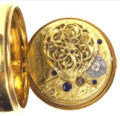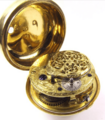James Ivory (watchmaker) facts for kids
Quick facts for kids
James Ivory
|
|
|---|---|

James Ivory pocket watch #109
|
|
| Born | 1729 |
| Died | 1793 (aged 63–64) |
| Nationality | Scottish |
| Scientific career | |
| Fields | Watchmaker |
James Ivory (born in 1729, died in 1793) was a very skilled Scottish watchmaker, clockmaker, and engraver. He made beautiful and precise timepieces. His son, Thomas Ivory, also followed in his footsteps for a short time.
Contents
The Life of James Ivory
James Ivory was a famous watchmaker and clockmaker in Dundee, Scotland. He lived and worked there in the mid-to-late 1700s. James was born in Liberton, near Edinburgh, in 1729.
Starting His Career
He learned his trade as an apprentice in London, England. We don't know exactly when he was there. In London, he married Jane Brown in 1761.
Moving to Dundee
In late 1762, James moved back to Scotland. He settled in Dundee, where he lived until he passed away in 1793. His first son, Sir James Ivory, was born in Dundee in 1765. Sadly, his wife Jane died soon after. James later married Margaret Cook in 1768. He had three sons and two daughters from his two marriages.
His Son Thomas
James's second son, Thomas, was born in 1770. Thomas learned the watchmaking trade from his father. He became a watchmaker himself in 1795. However, Thomas later changed careers in 1800. He started working in publishing instead. Thomas's son, also named James, later became known as Lord Ivory.
James Ivory's Important Work
James Ivory became a very respected clockmaker in Dundee and across the United Kingdom. He was trusted with important projects.
Making Clocks for Churches
In 1774, he made the clock for the steeple of St. Andrew's Parish Church in Dundee. This clock is still working today!
Serving His Community
James also served as a Town Councillor in Dundee. He held this position from 1768 until 1789. While he was a councillor, his eldest son, Sir James Ivory, became a teacher. His son taught at the Dundee Academy.
His Workshop and Creations
After his apprenticeship in London, James opened his own workshop there. That's why his very first pieces have "London" engraved on them. He later moved his workshop to Dundee. From the mid-1750s until 1793, he made many different timepieces. These included pocket watches, tall hall clocks, and wall clocks.
Many of his clocks and watches used a special type of mechanism. It was called the verge fusee escapement. Most of his pocket watches had specific features. They often had "beetle and poker"-style hands and white enamel faces. James Ivory's pieces are very valuable today. Auction houses say they were "the best that money could buy in London at the time."
The Art of Watchmaking
James Ivory was known for the high quality and beauty of his work. He didn't just make many watches; he made each one special.
How Many Watches Did He Make?
From 1759 to 1768, James made about 20 watches each year. Between 1769 and 1774, this number grew to about 78 watches a year. This might seem like a small number compared to other makers. Some workshops produced hundreds or even thousands of movements yearly. This shows that James Ivory did most of the work himself. He didn't rely on many apprentices like others did.
His Unique Engraving Style
James was also an engraver. This meant he personally created most of the detailed designs on his watch movements. Other makers often bought finished parts from suppliers. They might also have their apprentices do the engraving and finishing. But James Ivory did much of this intricate work himself. His only known apprentice was his son, Thomas, and that was only in the last few years of his life.
Why His Work Stands Out
Collectors really want James Ivory's pieces, especially his early works from the 1760s. The detailed engravings and decorations on his movements are very fine and elegant. During his career, many other watchmakers started to reduce the amount of artistic detail. This was partly because of "dust covers" being used on pocket watch movements. Dust covers were introduced in the late 1700s.
James himself started using dust covers on his movements in 1774. Other makers who used dust covers or newer escapements (like duplex escapements) often had less artistic decoration. But James Ivory continued the grand, detailed style of watchmaking. He kept this tradition alive until he passed away in 1793.
Images for kids





